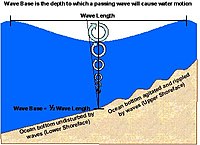
Photo from wikipedia
Shelf-edge deltas are a key depositional environment for accreting sediment onto shelf-margin clinoforms. The Moruga Formation, part of the palaeo-Orinoco shelf-margin sedimentary prism of south-east Trinidad, provides new insight into… Click to show full abstract
Shelf-edge deltas are a key depositional environment for accreting sediment onto shelf-margin clinoforms. The Moruga Formation, part of the palaeo-Orinoco shelf-margin sedimentary prism of south-east Trinidad, provides new insight into the incremental growth of a Pliocene, storm wave-dominated shelf margin. Relatively little is known about the mechanisms of sand bypass from the shelf-break area of margins, and in particular from storm-wave dominated margins which are generally characterized by drifting of sand along strike until meeting a canyon or channel. The studied St. Hilaire Siltstone and Trinity Hills Sandstone succession is 260 m thick and demonstrates a continuous transition from gullied (with turbidites) uppermost slope upward to storm wave-dominated delta front on the outermost shelf. The basal upper-slope deposits are dominantly mass-transport deposited blocks, as well as associated turbidites and debrites with common soft-sediment-deformed strata. The overlying uppermost slope succession exhibits a spectacular set of gullies, which are separated by abundant slump-scar unconformities (tops of rotational slides), then filled with debris-flow conglomerates and sandy turbidite beds with interbedded mudstones. The top of the study succession, on the outer-shelf area, contains repeated upward-coarsening, sandstone-rich parasequences (2 to 15 m thick) with abundant hummocky and swaley cross-stratification, clear evidence of storm-swell and storm-wave dominated conditions. The observations suggest reconstruction of the unstable shelf margin as follows: (i) the aggradational storm wave-dominated, shelf-edge delta front became unstable and collapsed down the slope; (ii) the excavated scars of the shelf margin became gullied, but gradually healed (aggraded) by repeated infilling by debris flows and turbidites and then new gullying and further infilling; and (iii) renewed storm wave-dominated delta-front prograded out across the healed outer shelf, re-establishing the newly stabilized shelf margin. The Moruga Formation study, along with only a few others in the literature, confirms the sediment bypass ability of storm-wave dominated reaches of shelf edges, despite river-dominated deltas being, by far, the most efficient shelf-edge regime for sediment bypass at the shelf break. This article is protected by copyright. All rights reserved.
Journal Title: Sedimentology
Year Published: 2017
Link to full text (if available)
Share on Social Media: Sign Up to like & get
recommendations!